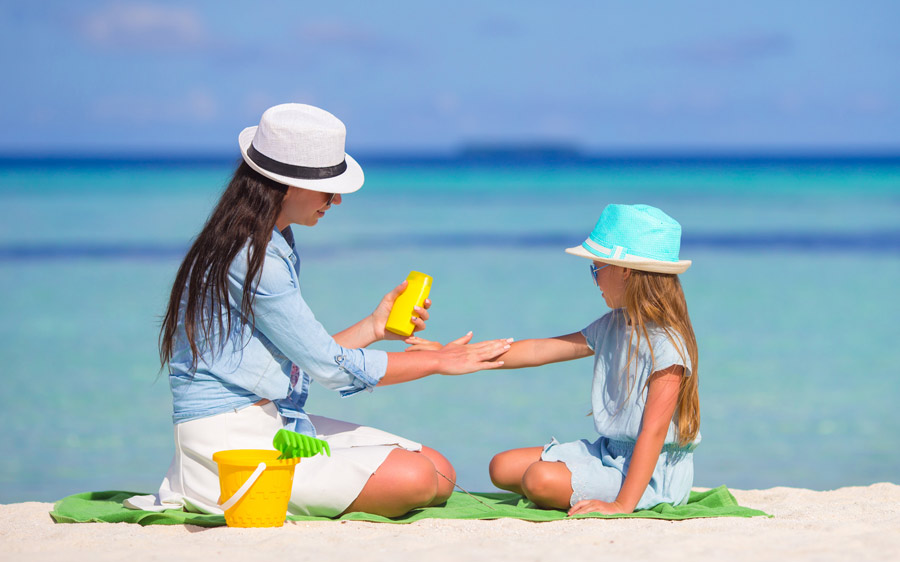A national poll shows that parents are doing a good job keeping their kids sun safe — but there’s always room for improvement!
Whenever kids venture outdoors, there are plenty of things to worry about: bug bites, scraped knees and allergies all top the list. Then, of course, there’s sun safety. Parents should practice effective sun protection with their children, both to protect kids as they enjoy time outside and instill lifelong healthy habits. Luckily, it seems that parents are getting the message: A national poll by C.S. Mott’s Children’s Hospital shows that most parents are using a variety of strategies to protect their child’s skin from the sun.
Sunscreen in the Spotlight
The good news: Ninety-two percent of parents polled considered sunscreen important to prevent sunburn, and 89 percent thought it was important for preventing skin cancer.
Why it matters: One study found that regular daily use of sunscreen with an SPF (sun protection factor) of 15 or higher reduces the risk of developing melanoma by 50 percent when used as directed. Nearly half of parents said they choose sunscreen with an SPF of 45 or higher for their child, and about a third of parents said their minimum SPF requirement for a child’s sunscreen was 30. (The Skin Cancer Foundation recommends children use a water-resistant sunscreen with an SPF of 30 or higher.)
Keep Them Covered
The good news: Most parents surveyed also incorporated other sun protection methods into their child’s routine, including hats (71 percent) and long-sleeved clothing (66 percent).
Why it matters: Clothing is the single most effective form of sun protection for the body, so send kids outside in densely woven and bright or dark-colored fabrics, which offer the best defense. The more skin you cover, the better, so choose long sleeves and long pants whenever possible. The Skin Cancer Foundation also recommends dressing little ones in a wide-brimmed hat and UV-blocking sunglasses, to protect their face, neck and eyes. If they won’t wear a wide-brimmed hat, a baseball cap is better than nothing.
Don’t Let Your Guard Down
The bad news: The survey findings also suggested that some harmful misconceptions may be coloring parents’ sun protection choices. A mere 25 percent of parents said they would reapply sunscreen to their child on a cloudy day, and only 20 percent would reapply if their child was in a shady area. When deciding whether or not to have their child use any sun protection, most parents considered the following very important: how long their child will be outside (74%), what the child is wearing (66%), the child’s complexion/skin tone (62%), whether the child will be around water (62%) and how hot it is (57%).
Why it matters: The Skin Cancer Foundation urges parents to apply sun protection to children daily, regardless of the weather, a child’s skin tone and where the child will be. It’s true that parents should reapply sunscreen more if a child is outside for an extended period, but even incidental sun exposure adds up. Sunscreen should be applied and hats should be donned even if your little one is just tagging along for errands. It’s also true that having darker skin (which contains more melanin than fair skin) can provide a small amount of ultraviolet (UV) protection, but everyone is at risk of sun damage and skin cancer, regardless of complexion. Children of every race and ethnicity need sun protection.
While clouds block the majority of UVB rays, they do not stop UVA rays (which account for up to 95 percent of the UV radiation reaching Earth). This means that children are exposed to UV radiation even on hazy, cloudy and rainy days. Shade is also not a foolproof shield, as UV rays can reflect off surfaces like glass, sand, concrete and water.
The best news: Parents seem to be much more conscious and proactive about protecting their children from sun damage than they were 50, 30 or even just 10 years ago. There’s still plenty of work to be done, however. It’s important to educate yourself, understand the sneaky ways UV rays can damage your child’s skin and know that sun protection shouldn’t just be for certain occasions — it should be an everyday habit.





